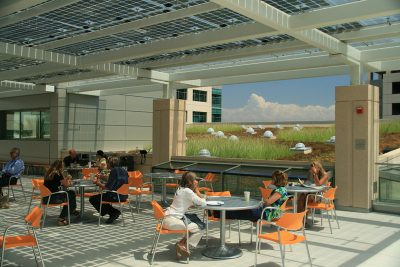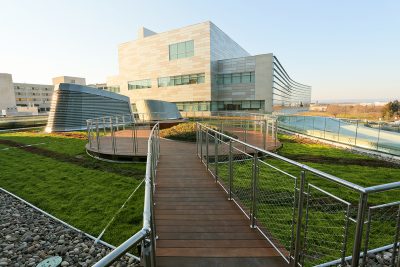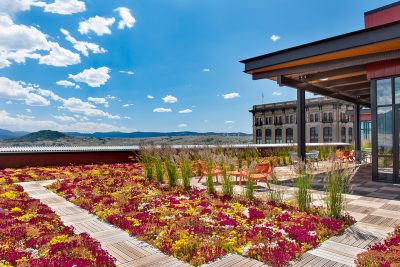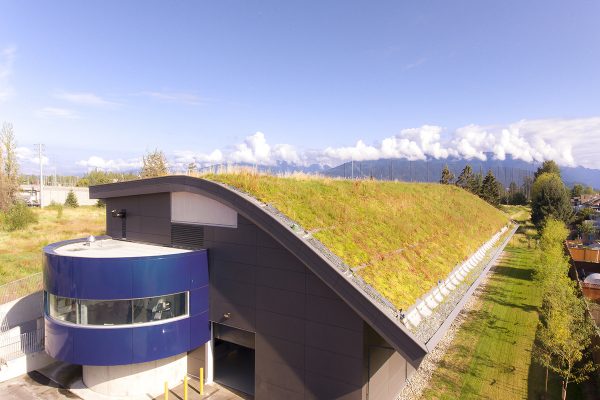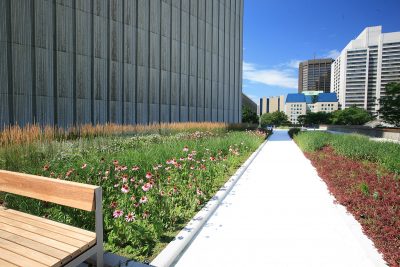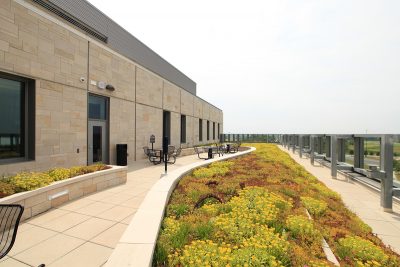Green Roof Benefits
Green roofs go beyond any other roofing option when it comes to the multitude of benefits they provide to those who own, work, and live under them. Green roofs are beautiful, create habitat, promote health and well-being, attract customers, reduce stormwater runoff, protect building envelopes, and conserve energy. To learn more about how to optimize the benefits of your specific green roof application, please reach out to your local representative.
Optimize Productivity & Profitability
BETTER ATTENDANCE
Workplaces that incorporate biophilic design elements such as access to nature have reduced absenteeism, fewer complaints, and improved staff retention.
IMPROVE FOCUS
Providing access to nature in the workplace can reduce eyestrain, relieve mental fatigue, and improve focus on tasks.
INCREASE OUTPUT
Integrating plants into workplaces yields productivity gains and reduced psychological stress.
EXPAND USABLE SPACE
Adding green roofs can expand the amount of usable space a facility can offer. By adding amenity space, building owners can increase the usable space of their facility. Rooftop patios, healing gardens, and other amenity spaces make buildings more attractive to building owners, tenants, and customers alike.
MAXIMIZE OCCUPANCY
Facilities with green roofs reach full occupancy faster than similar buildings in those markets. These buildings also attract new occupants quicker than traditional locations when openings become available.
REDUCE COOLING COSTS
Through the process of evapotranspiration, plants create a thermal barrier between the warming rays of the sun and the building. This barrier keeps the cool air inside the building, reducing the load on the air conditioning system.
HIGHER RENTS
Green roofs can be used to improve the view in leased space, translating into more dollars that guests or tenants are willing to spend.
Promote Health & Wellness
RECOVER FASTER
Patients who physically interact with plants use less medication and experience significantly reduced recovery times after medical procedures.
ENHANCE PATIENT EXPERIENCE
Using planted roofs to improve views or provide places of respite in healthcare enhances the experience of patients, visitors, and staff, who report greater satisfaction and positive feelings in the presence of nature.
Support Marketing & Public Relations
DEMONSTRATE STEWARDSHIP
A living roof tells customers, residents, employees, or neighbors that you care about your community, your health, and the ecosystem.
COMMUNITY HEALTH
Living roofs as part of green communities increase sense of pride and place, levels of trust, and civic participation. These communities see less violence, aggression, vandalism, and littering.
GREEN SPACE COMPLIANCE
Green roofs typically qualify for credits associated with green/open space and onsite stormwater management in many municipal zoning ordinances, often equating to time and money savings in the zoning process, or financial rewards from tax credits and other incentives.
Improved Air & Water Quality
REDUCE STORMWATER RUNOFF
Research has shown that extensive green roof systems can reduce runoff by up to 90+% annually (varies with climate, soil, and pitch of roof). Living roofs act as a sponge to absorb much of this runoff and keep waterways cleaner.
CLEAN WATER
Urban environments, with their expanses of impermeable surfaces, allow stormwater to runoff directly into municipal sewer systems. Green roofs reduce stormwater runoff and the likelihood of combined sewage overflows into local waterways.
PREVENT POLLUTION
Rainwater that runs off impermeable surfaces rinses pollutants into local waterways. Vegetated roofs filter these pollutants from the runoff before it reaches municipal water treatment facilities.
INCREASE OXYGEN
Plants naturally infuse the air with oxygen and reduce carbon dioxide levels for overall improved air quality. Plant leaves, roots, and soil can remove traces of toxic chemicals such as carbon monoxide and formaldehyde.
REDUCE NOISE
Plants, soil, and air trapped in the soil are acoustic insulators. Green roofs dampen and reduce noise, which is a great benefit to occupants of buildings affected by airports, industry, trains, and traffic.
IMPROVE INDOOR AIR QUALITY
Researchers have found green roofs to improve the quality of air brought into a building through outdoor intake vents.
Conserve Financial and Environmental Resources
RESTORE HABITAT
Plants and soil help recreate habitat for pollinators such as bees, butterflies, insects, and songbirds.
SAVE ENERGY
The evapotranspirative effects of green roof plants and the growing medium reduce HVAC costs during hot weather.
PROTECT BUILDING ENVELOPE
Plants and soil protect membranes from UV radiation, temperature fluctuations, and high winds.
FIRE PREVENTION
Succulent green roof plants and inorganic growing media help reduce the risk of fire.
REDUCE HEAT ISLANDS
Green roof vegetation helps cool the air, slow air movement, and acts as a substrate for pollution to settle out and detoxify.
CONSERVE MUNICIPAL STORM SYSTEMS
The soil in green roof systems acts like a sponge and absorbs excess rainwater, and thus municipal stormwater systems do not have to be expanded as much. It also means reduced overflows as well as reduced pollution and associated costs.
Enhance Education
ENHANCE PERFORMANCE
Student exposure to nature has been correlated with higher academic performance in Math and English.
IMPROVE FOCUS
Studies have also demonstrated that exposure to nature eases symptoms of ADHD.
TEACH STEWARDSHIP
Students who are exposed to the maintenance of green roofs learn about the vital role of plants in air quality, stormwater management, and climate control.
SolaGreen (Solar + LiveRoof)
GENERAL
All of the benefits that you see listed above are, or can be, benefits of a SolaGreen roof.
FINANCIAL
A SolaGreen roof can generate electricity in a more economical and efficient manner than most other options. And, because solar power generation is often incentivized with grants and tax codes, installing a SolaGreen roof may provide grant funding and tax incentives for the LiveRoof component as well (lowering its cost), as the LiveRoof system is an essential element of the solar array.


